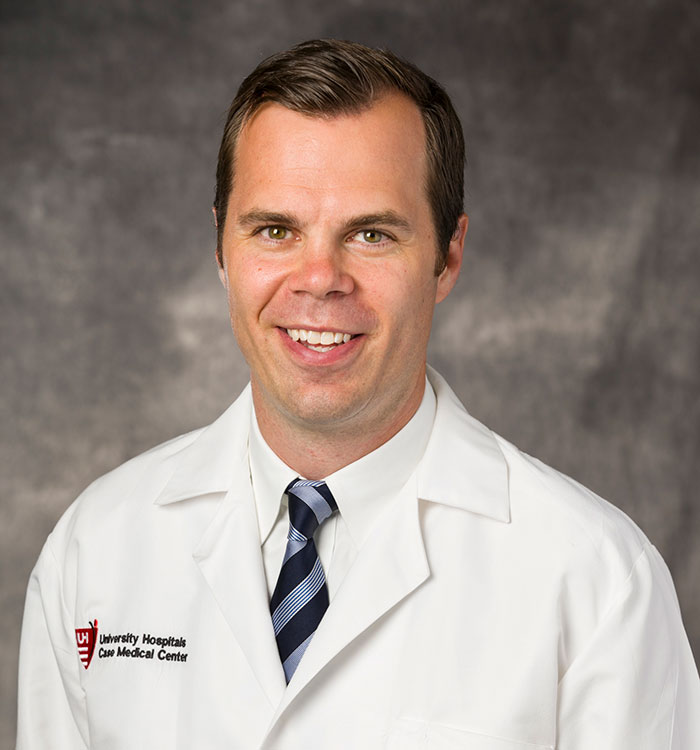UH Department of Orthopaedics Quickly Adapts to Support Patients and Staff During COVID-19 Pandemic
June 22, 2020
Continuing care through crisis
Innovations in Orthopaedics | Summer 2020
 James Voos, MD.
James Voos, MD.From rescheduling planned surgeries to maintaining care pathways for trauma patients, leaders at the University Hospitals’ Department of Orthopaedics were committed to delivering consistent care as they prepared for a potential surge of COVID-19 patients this March.
“There was a lot of communication and cooperation amongst our colleagues in anesthesia, the ER and radiology to ensure that patients would still get the care that they need,” says James Voos, MD, chair of the Department of Orthopaedic Surgery, Jack & Mary Herrick Distinguished Chair, Orthopaedics and Sports Medicine at UH Cleveland Medical Center, and Associate Professor of Pediatrics, Case Western Reserve University School of Medicine.
A THREE-PRONGED APPROACH
To prepare and respond to the COVID-19 health event, department leaders focused on three primary areas. First was ensuring the continued safety of physicians, residents and staff.
Frequent “clinical huddles” amongst the leadership team provided a forum to discuss clinical needs and safety measures. Did all staff have adequate cleaning supplies and masks? Did everyone understand the protocols?
General faculty was also more involved in creating call schedules, so team members had appropriate days off and no one person was in an area of exposure multiple days in a row — especially orthopaedic trauma surgeons. “We have the busiest trauma center in northeast Ohio,” Dr. Voos explains. “So we must be cognizant of how we protect those doctors on the front line to ensure they can still provide excellent care and that they are safe.”
Continuing the educational program for orthopaedic residents — while helping them understand how to protect themselves, patients and loved ones from the virus — was another priority. “We provided frequent education and answered their questions to make sure that they felt comfortable,” Dr. Voos says. To ensure there was always a healthy, protected group of residents to rotate in, the department instituted a three-group rotation: One group to handle emergency and urgent needs at main campus, a second group to rotate through the metro system, and a third group that remained home.
Finally, physicians and staff prepared to assist colleagues in the ER, ICU or on a medical floor if there was an overflow of COVID-19 patients. All department physicians filled out a needs assessment to determine how they could help, and preparations were made to use orthopaedic clinics at University Hospitals Ahuja Medical Center and main campus as temporary orthopaedic ERs (keeping regular beds open for COVID patients), among other changes.
FINDING SILVER LININGS
Through March and April, Dr. Voos estimates that the Department of Orthopaedics operated at just one-third of its normal capacity. But team members found several silver linings, despite the uncertainty.
With fewer clinical cases, residents and faculty took time to ramp up research efforts and submit new grant applications and manuscripts. They also embraced new digital technologies for internal and patient communications. Daily departmental lectures by faculty were converted to virtual meetings, with positive results. “We had incredible feedback from our residents that they felt very engaged and they like the interaction of the faculty and residents together,” Dr. Voos says. “We’re likely to continue that format in some capacity moving forward.”
Virtual video visits will also become part of the department’s normal workflow for select orthopaedic patients. As of mid-March 2020, the Department of Orthopaedics had performed no virtual health visits as part of its normal patient workflow, Dr. Voos says. But up to 40% of patient visits were performed virtually during this period. “I was very impressed with our offices being able to integrate this technology and with patients’ willingness to participate,” he says.
The desire to keep patients out of the hospital setting has also helped the department accelerate the shift to outpatient orthopaedic procedures — specifically, total joint replacements (TJRs). Outpatient TJRs will allow more patients undergoing surgery to recover at home with less potential for exposure. “This environment has allowed us to ramp up that program safely for select patients, as well as continue it moving forward,” Dr. Voos says.
As more orthopaedic patients return to in-person visits, they’ll experience some longer-term changes, including enhanced cleaning in exam rooms and common areas, barriers in waiting rooms and universal masking. Those undergoing a surgical procedure will now require pre-op COVID testing 48-72 hours before their surgery to protect them and their fellow patients. Meanwhile, the department has extended clinic opening and closing hours to support the updates. “We can accommodate the volume of patients that we need to see while still keeping that appropriate distancing and preventing the waiting rooms from getting overcrowded,” Dr. Voos says.
Dr. Voos is also encouraged by the department’s return to 90% patient volume as of May 2020. “While there’s always apprehension with the time of low volume and what’s going to happen with the pandemic, we’ve had high morale with everybody working as a cohesive unit,” he says. “By keeping close communication with our patients and maintaining their comfort level, we were able to get them back on the schedule and take care of their orthopedic needs in a very timely fashion.”
For more information or to refer a patient, call 216-553-1783.


